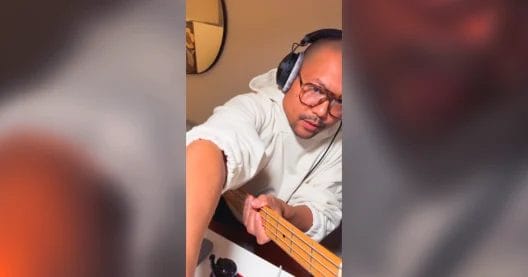When I was in my twenties, my hands were fast, my time was steady, and my mind could lock into even the simplest bass groove for hours. I remember jamming with my brother for four hours straight—playing the same funk groove over and over and driving our roommates mad.
Now at 46, things feel different. My fingers are clumsier. My attention wanders… a lot. Sometimes I’ll be deep in a bass groove practice and suddenly think, “I gotta get the clothes out of the laundry and into the dryer…” or “I really need to pay that gas bill…”
But that’s okay—because I’ve learned something new about developing time-feel: presence is everything.
Breathing With the Drums
Today, I pulled up Maceo Parker’s “Southwick” and decided to isolate four bars of Bill Stewart’s drum groove.
My goal wasn’t to learn the bass line faster — it was to feel it deeper. I wanted to see how well my bass could breathe alongside Bill Stewart’s playing. To do that, I removed every other instrument and locked in with just the drums.
For the next hour, I looped those four bars and tried to get my whole body to breathe with the drummer. To stretch where time wanted to stretch. To tighten where it wanted to tighten. To stay loose where it needed space.
My aim was to capture the original groove feel and not just to copy the notes, but to embody the conversation happening between the bass and drums, as if I were the one on that recording.
What started as a casual warm-up turned into a humbling, meditative groove practice — one that revealed just how much depth lives inside four simple bars.
Here’s what that hour taught me.
1) The Quarter Note Is Home Base
If your quarter note feels good (even if that quarter note is a rest), the whole groove feels good.
Every time I drifted mentally, I could hear it. My bass lines lost weight, the pocket loosened, and the rhythmic feel stopped feeling inevitable. But the moment I came back to simply feeling the quarter note, the groove locked in again.
A lot of players will say beat one is the most important beat. And sure, it’s an anchor, but in a funk bass groove, every quarter note matters. The quarter note is the gravitational center of the groove. Everything else orbits it.
So if something in your bass groove practice isn’t quite locking, don’t rush to fix your fills or ghost notes. Instead, hone in on your quarter notes. Make sure each one is breathing with the drummer, feels consistent, and grounded in time.
2) Every Upbeat Belongs to a Quarter Note
Each upbeat wants to pull toward something — sometimes toward beat 1, sometimes 2, 3, or 4. The “and” of 2 leans into 3; the “e” of 1 pulls back toward 1. When you place those upbeats just right, you feel a magnetic pull that makes the groove come alive.
This is a subtle kind of time-feel practice that takes a lot of experimenting. Sometimes pulling back on a beat isn’t what the music needs; sometimes you actually have to lean forward.
Whatever direction you choose, focus on how your upbeat placement affects the surrounding quarter notes. Notice how a slightly early or late upbeat changes the groove feel, the tension, the release, and the flow.
That small awareness completely changed how I heard my own bass phrasing. Suddenly the groove pocket wasn’t just a metronomic grid; it became a conversation with the drummer. And as the session went on, I could feel my groove deepen with every round of that four-bar loop.
3) Groove Is About Breathing, Not “Locking”
For years, I thought locking in meant tightening my timing. Now I realize it’s more about alignment than accuracy.
Developing time-feel isn’t about matching a metronome — it’s about breathing with the drums.
When I listened closely to Bill Stewart’s drum phrasing, I could hear the way he exhaled through fills and relaxed into the pocket. My best takes were the ones where I mirrored that breath, and where I let the bass groove expand and contract like lungs.
That’s when everything started to feel alive and when my body began to move on its own and I couldn’t stop.
This practice completely shifted how I define locking in. I’m not trying to “bury the metronome” or “bury the beat.” I’m trying to create a pull between me and the drummer.
Honest Practice, Honest Progress
One hour might not sound like much, but it was one honest hour that made a noticeable difference in my time-feel.
Groove practice at 46 doesn’t look like it did in my 20s. It’s slower, deeper, more mindful. And it’s teaching me that improvement isn’t about speed or stamina — it’s all about attention.
If you’re returning to the bass after years away, or just feeling like your playing’s lost its pocket, don’t chase complexity. Find one small loop that humbles you and live inside it for a while.
Groove is repetition with purpose. Dive deeper into pocket-building ideas inside Music & Bass →









